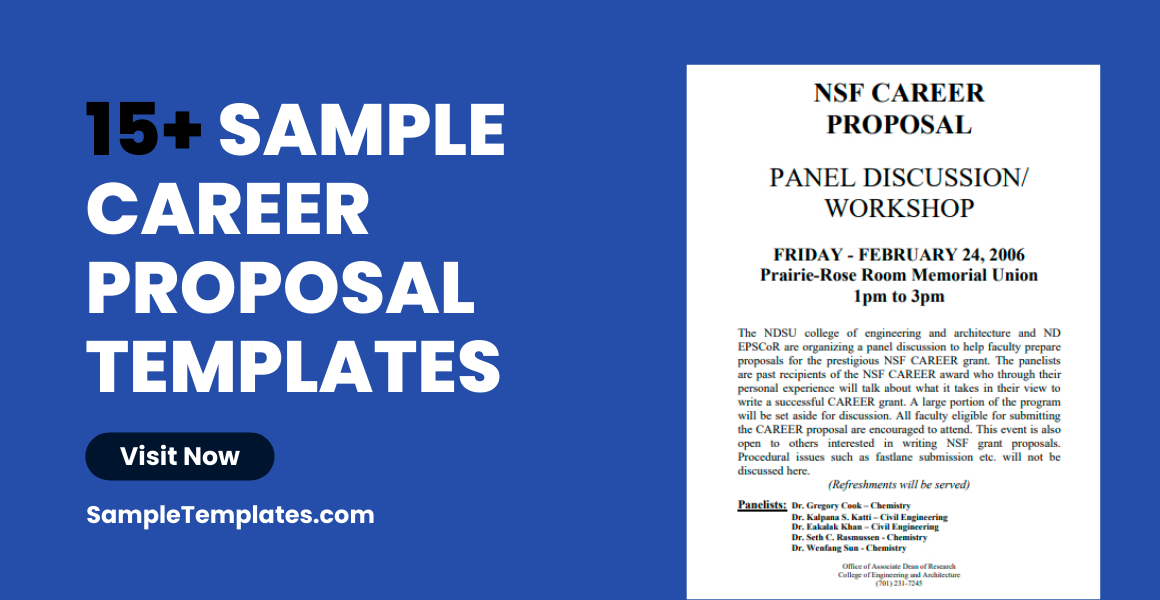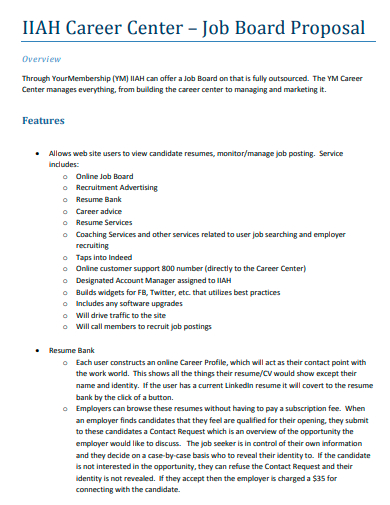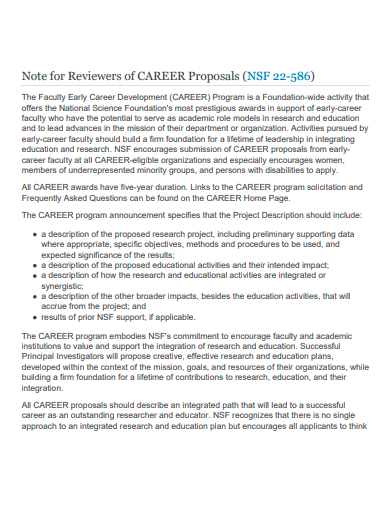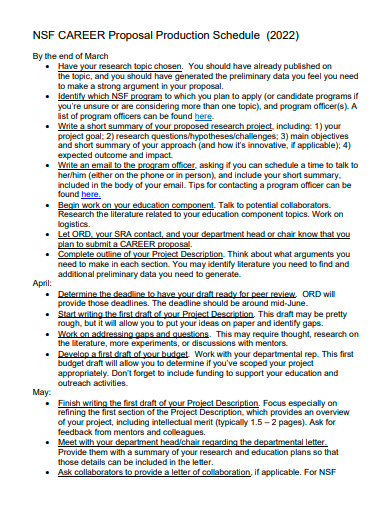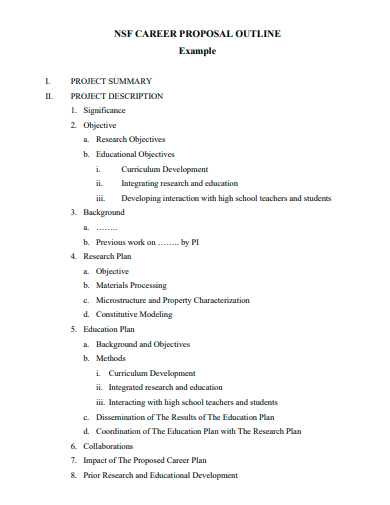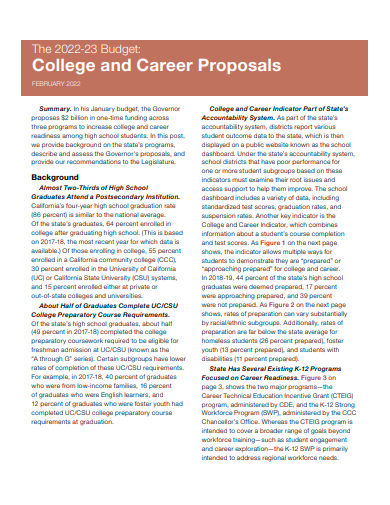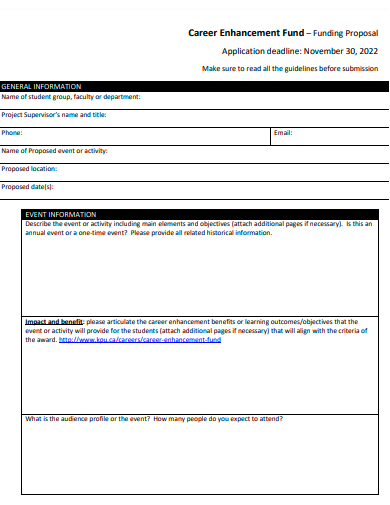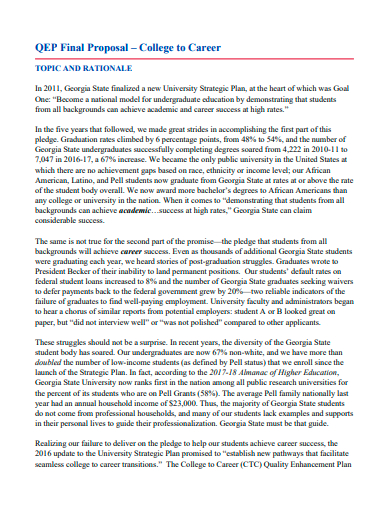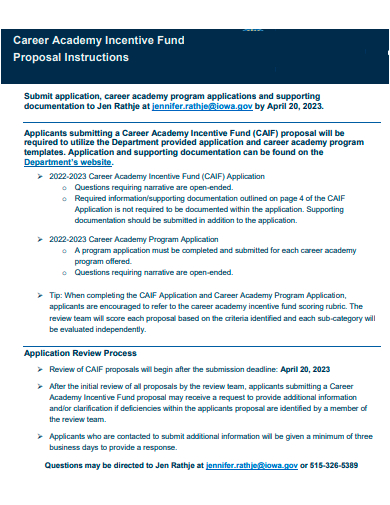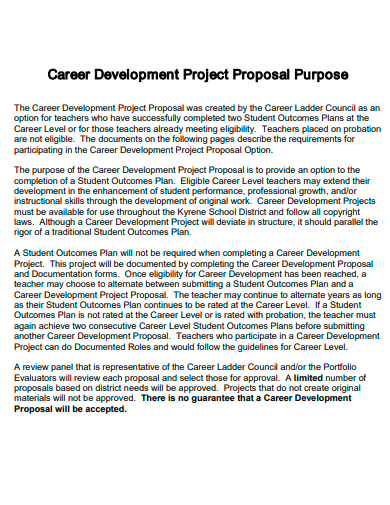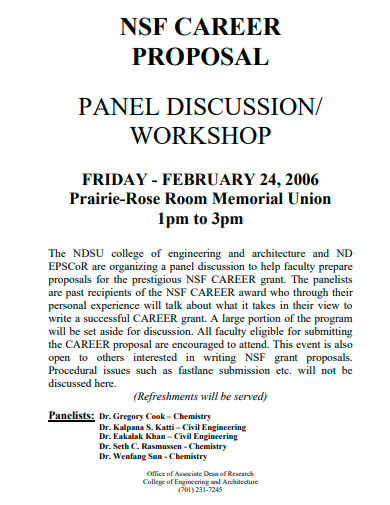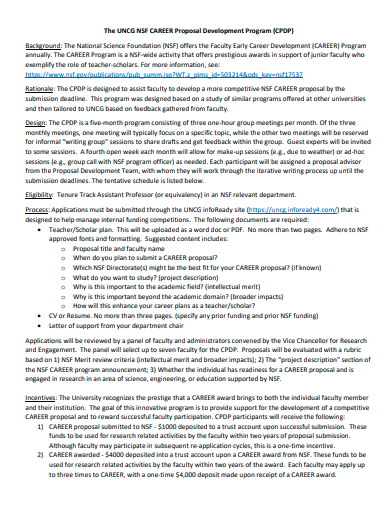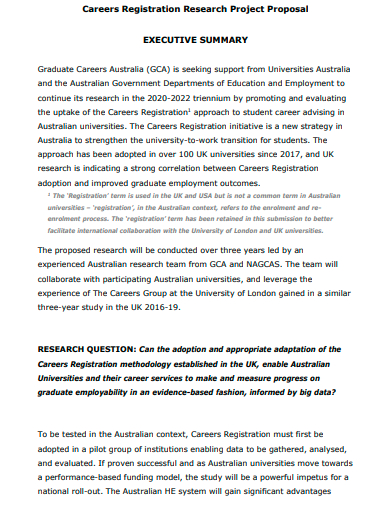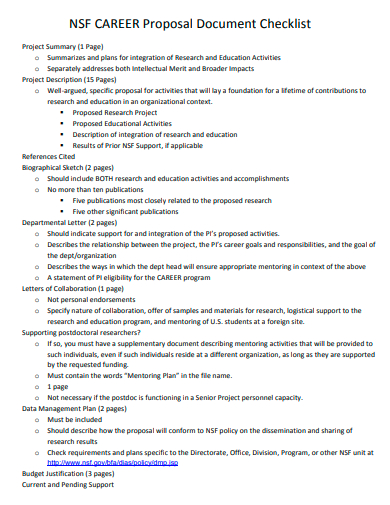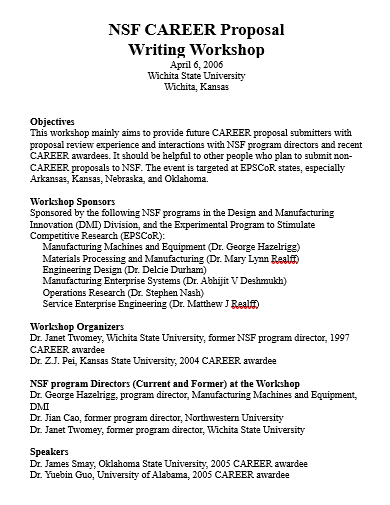Chart a path to success in both career progression and grant acquisition with our Sample Career Proposal Template. Perfect for individuals across all professional levels, this template simplifies the process of highlighting your achievements and potential. It’s more than just a career roadmap; it’s your ally in drafting an impactful grant proposal. Elevate your chances with potential employers and grant bodies through this thoughtfully curated guide.
15+ Career Proposal Samples
1. Career Center Job Board Proposal Template
2. Career Proposal Template
3. Departmental Letter Career Proposal Template
4. Career Proposal Production Schedule Template
5. Career Proposal Outline Example
How to Write a Career Proposal
A career proposal is a structured document that outlines your professional goals, the steps you intend to take to achieve them, and the resources or support you might need. Whether you’re seeking a promotion, a lateral move, or presenting your ambitions to a potential employer, a well-crafted career proposal can set you apart from the competition. Here’s how to write an effective one:
Introduction:
Start with a concise introduction that provides a snapshot of your current professional status and your ambitions. It should grab the reader’s attention and make them want to read more about your plan.
Clearly Defined Objective:
Clearly state what you aim to achieve with this proposal. Whether it’s securing a specific job position, pursuing further education, or obtaining a grant, ensure your objective is precise and attainable.
Background and Qualifications:
Detail your educational background, work experience, skills, and other qualifications that make you a suitable candidate to achieve the proposed objective. Using quantifiable achievements can make this section more impactful.
Detailed Plan of Action:
Break down your career proposal into actionable steps. This could be a timeline of positions you intend to hold, training you plan to undergo, or projects you want to undertake. Each step should logically lead to the next, and collectively, they should lead to the realization of your objective.
Resources Required:
Here, specify any resources you might need to realize your plan. This could range from additional training, mentorship, financial support (for courses or certifications), to particular tools or software.
Potential Challenges and Solutions:
Demonstrating foresight by identifying potential challenges and providing solutions shows your preparedness and commitment. Address any obstacles you anticipate, from gaps in your knowledge to market conditions, and provide a plan to navigate or overcome them.
Benefits to the Organization:
If presenting your proposal to your current employer, highlight how your career growth will benefit the organization. This could be in terms of skills you’ll acquire that are beneficial to the team, leadership roles you’ll be ready to take on, or the added value you’ll bring from an expanded network or knowledge base.
Conclusion:
Wrap up your career proposal by summarizing your objectives, reiterating the value you bring, and expressing gratitude for the opportunity to present your ambitions. A call to action, such as a request for a follow-up meeting, can also be added here.
Professional Presentation:
Ensure your career proposal is free of errors and is presented professionally. Use a clean format, consistent font, and organized headings. If appropriate, include charts or graphs to illustrate certain points.
Feedback and Revision:
Before finalizing your proposal, seek feedback. This could be from mentors, colleagues, or professionals in the field you’re targeting. Use their insights to refine and enhance your proposal.
Remember, a career proposal is not just a document; it’s a representation of your professional ambitions. Crafting it with clarity, precision, and a touch of personal flair can not only propel you towards your career goals but also open doors to opportunities you hadn’t foreseen.
6. College and Career Proposal Template
7. Career Enhancement Funding Proposal Template
8. College to Career Final Proposal Template
9. Career Academy Incentive Fund Proposal Template
10. Career Development Project Proposal Template
Elements of a Career Proposal
A career proposal is a valuable tool in mapping out desired career progressions or changes. Whether you’re planning internally within an organization or outlining future ambitions for yourself or a potential employer, knowing the elements that comprise an effective career proposal is crucial. Let’s delve into these components in detail:
Title or Header:
Begin with a clear and concise title, such as “Career Development Proposal for [Your Name]” or “Proposed Career Pathway for [Year].” This sets a professional tone and provides immediate clarity on the document’s purpose.
Introduction:
This is a brief overview of the proposal, outlining its intent. It can also touch upon your current professional standing and the reasons you are considering a specific career direction or advancement.
Objective Statement:
Clearly and succinctly state the primary goal of your proposal. What do you want to achieve? Whether it’s climbing the corporate ladder, transitioning into a different industry, or seeking professional development opportunities, pinpoint your target.
Background and Qualifications:
This section encompasses your professional journey to date. Highlight your education, work experience, accomplishments, and any relevant skills that support your proposal. Remember, this is a chance to showcase why you’re the right person for the proposed career path.
Proposed Career Path or Position:
Detail the position or career path you’re aiming for. Describe the role, responsibilities, and why it appeals to you or how it fits into your long-term goals.
Plan of Action:
What steps will you take to reach your career objective? This could involve additional training, attending workshops, seeking mentorships, or even timeline-oriented goals for moving up within an organization. The clearer your roadmap, the more actionable and realistic your proposal appears.
Resources Needed:
Identify the tools, courses, mentorships, or any other resources that would support your journey. If you’re presenting the proposal to your current employer, this section is especially crucial, as it outlines the support you’re seeking from the organization.
Benefits to the Stakeholder:
If you’re presenting this to an employer or any other stakeholder, highlight how your proposed career path will not only benefit you but also them. Will it improve team dynamics? Will it bring in a skill set that’s currently lacking in the company? Or perhaps, will it position the organization better in the market?
Potential Obstacles and Solutions:
Any journey has its challenges. By acknowledging potential hurdles and proposing solutions, you demonstrate foresight, maturity, and commitment to your career goals.
Conclusion and Call to Action:
Summarize the key points of your proposal and conclude with a clear call to action, like seeking endorsement, asking for a meeting, or requesting feedback.
Appendices (if necessary):
Include any supplementary materials that can support your proposal, such as letters of recommendation, certificates, or detailed training programs.
In essence, a career proposal is a structured reflection of your professional ambitions, a roadmap to your future. Crafting it with clarity and a strategic outlook can serve as a catalyst, propelling you towards the success you envision.
11. Sample Career Proposal Template
12. Career Proposal Development Program Template
13. Careers Registration Research Project Proposal Template
14. Career Day Program Proposal Template
15. Career Proposal Document Checklist Template
16. Workshop Career Proposal Template
What Does a Good Proposal Include?
A well-structured proposal, regardless of its specific intent or audience, is a persuasive document designed to convince the reader of the value and feasibility of a particular project or idea. Here’s a breakdown of the elements that a robust proposal should encompass:
Title and Introduction:
Your proposal should start with a compelling title that gives a snapshot of the project’s core idea. The introduction provides context, setting the stage for why the proposal is necessary and what it aims to achieve.
Executive Summary:
For longer proposals, an executive summary offers a concise overview of the project’s goals, methodology, benefits, and anticipated outcomes. It should be written in a way that even those unfamiliar with the subject can grasp the proposal’s essence.
Objectives and Goals:
Clearly state the purpose of the proposal. What do you hope to achieve? Define specific, measurable, achievable, relevant, and time-bound (SMART) objectives that can guide the project’s execution and evaluation.
Background or Problem Statement:
Offer context. If the proposal aims to solve a problem, articulate that problem clearly. Use data, research, and other relevant information to paint a picture of the current situation and why your proposal is necessary.
Methodology:
Detail the steps, techniques, and strategies you plan to use to achieve the proposal’s objectives. This showcases the feasibility of your proposal and assures stakeholders of its practicality.
Scope and Limitations:
Define the boundaries of your proposal. What will it cover, and what falls outside its purview? Being transparent about limitations demonstrates thoroughness and integrity.
Timeline:
Provide a chronological breakdown of how and when different phases of the project will be executed. This ensures everyone understands the project’s pace and sequence.
Budget:
An itemized budget showcases the financial resources required. Include costs for materials, labor, equipment, and other expenses. For comprehensive proposals, consider adding a return on investment (ROI) analysis.
Benefits and Outcomes:
Highlight the potential positive impacts of your proposal. These could be tangible, like financial profits, or intangible, like improved brand reputation or increased customer satisfaction.
Risks and Contingency Plans:
Identify potential challenges or roadblocks and how you plan to address them. This shows preparedness and instills confidence in stakeholders.
Conclusion:
Summarize the main points of the proposal, reiterating its importance and the value it brings. Encourage the reader to take the desired action, whether that’s approval, funding, or feedback.
References:
Cite all sources, data, research, and materials referenced in your proposal to bolster its credibility.
Appendices (if necessary):
For detailed data, charts, diagrams, or supplementary information that might disrupt the main proposal’s flow, use an appendix.
Crafting a compelling proposal requires a mix of thorough research, clear writing, and strategic thinking. A good proposal not only presents an idea but also convinces the reader of its merit and feasibility.
Related Posts
FREE 11+ Engineering Project Proposal Samples in PDF | MS Word
FREE 4+ Racing Sponsorship Proposal Samples [ Team, Car, Driver ]
FREE 10+ Nursing Project Proposal Samples [ Community, Health, Clinical ]
FREE 11+ Student Council Proposal Samples in PDF | DOC
FREE 10+ Facilities Management Proposal Samples in MS Word | Google Docs | Apple Pages | PDF
FREE 8+ Joint Venture Proposal Samples [ Commercial, Real Estate, Construction ]
FREE 10+ Scholarship Proposal Samples [ Project, Grant, Sponsorship ]
FREE 10+ Computer Purchase Proposal Samples in MS Word | Google Docs | Apple Pages | PDF
FREE 10+ Network Project Proposal Samples [ Design, Security, Bank ]
FREE 14+ Accounting Proposal Samples in PDF | MS Word
FREE 10+ Church Event Proposal Samples in MS Word | Google Docs | Apple Pages | PDF
FREE 10+ History Proposal Samples [ Dissertation, Thesis, Paper ]
FREE 34+ Sponsorship Proposal Samples in PDF | MS Word | Pages | Google Docs
FREE 11+ Cost Proposal Samples & Templates in PDF
FREE 11+ Maintenance Proposal Samples in MS Word | Google Docs | PDF
